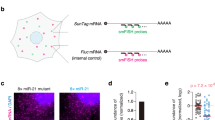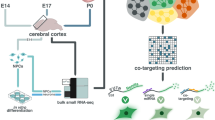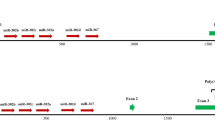Abstract
MicroRNAs (miRNAs) are endogenous noncoding RNAs (∼22 nt) that regulate target gene expression at the post-transcriptional level in the cytoplasm. Recent discoveries of the presence of miRNAs and miRNA function-required argonaute family proteins in the cell nucleus have prompted us to hypothesize that miRNAs may also have regulatory functions in the cell nucleus. In this study, we demonstrate that mouse miR-709 is predominantly located in the nucleus of various cell types and that its nuclear localization pattern rapidly changes upon apoptotic stimuli. In the cell nucleus, miR-709 directly binds to a 19-nt miR-709 recognition element on pri-miR-15a/16-1 and prevents its processing into pre-miR-15a/16-1, leading to a suppression of miR-15a/16-1 maturation. Furthermore, nuclear miR-709 participates in the regulation of cell apoptosis through the miR-15a/16-1 pathway. In summary, the present study provides the first evidence that one miRNA can control the biogenesis of other miRNAs by directly targeting their primary transcripts in the nucleus.
Similar content being viewed by others
Log in or create a free account to read this content
Gain free access to this article, as well as selected content from this journal and more on nature.com
or
References
Bartel DP . MicroRNAs: genomics, biogenesis, mechanism, and function. Cell 2004; 116:281–297.
Ambros V . The functions of animal microRNAs. Nature 2004; 431:350–355.
Kim VN . MicroRNA precursors in motion: exportin-5 mediates their nuclear export. Trends Cell Biol 2004; 14:156–159.
Lewis BP, Burge CB, Bartel DP . Conserved seed pairing, often flanked by adenosines, indicates that thousands of human genes are microRNA targets. Cell 2005; 120:15–20.
Schnall-Levin M, Zhao Y, Perrimon N, Berger B . Conserved microRNA targeting in Drosophila is as widespread in coding regions as in 3'UTRs. Proc Natl Acad Sci USA 2010; 107:15751–15756.
Shin C, Nam JW, Farh KK, Chiang HR, Shkumatava A, Bartel DP . Expanding the microRNA targeting code: functional sites with centered pairing. Mol Cell 2010; 38:789–802.
Meister G, Landthaler M, Patkaniowska A, Dorsett Y, Teng G, Tuschl T . Human Argonaute2 mediates RNA cleavage targeted by miRNAs and siRNAs. Mol Cell 2004; 15:185–197.
Ritland Politz J, Zhang F, Pederson T . MicroRNA-206 colocalizes with ribosome-rich regions in both the nucleolus and cytoplasm of rat myogenic cells. Proc Natl Acad Sci USA 2006; 103:18957.
Hwang HW, Wentzel EA, Mendell JT . A hexanucleotide element directs microRNA nuclear import. Science 2007; 315:97–100.
Ritland Politz J, Hogan E, Pederson T . MicroRNAs with a nucleolar location. RNA 2009; 15:1705.
Ohrt T, Mutze J, Staroske W, et al. Fluorescence correlation spectroscopy and fluorescence cross-correlation spectroscopy reveal the cytoplasmic origination of loaded nuclear RISC in vivo in human cells. Nucleic Acids Res 2008; 36:6439–6449.
Bian Z, Li LM, Tang R, et al. Identification of mouse liver mitochondria-associated miRNAs and their potential biological functions. Cell Res 2010; 20:1076–1078.
Rehmsmeier M, Steffen P, Hochsmann M, Giegerich R . Fast and effective prediction of microRNA/target duplexes. RNA 2004; 10:1507–1517.
Landgraf P, Rusu M, Sheridan R, et al. A mammalian microRNA expression atlas based on small RNA library sequencing. Cell 2007; 129:1401–1414.
Calin GA, Liu CG, Sevignani C, et al. MicroRNA profiling reveals distinct signatures in B cell chronic lymphocytic leukemias. Proc Natl Acad Sci USA 2004; 101:11755–11760.
Cimmino A, Calin GA, Fabbri M, et al. miR-15 and miR-16 induce apoptosis by targeting BCL2. Proc Natl Acad Sci USA 2005; 102:13944–13949.
Wagner A, Small M, Hay N . Myc-mediated apoptosis is blocked by ectopic expression of Bcl-2. Mol Cell Biol 1993; 13:2432.
Bian Z, Li L, Cui J, et al. Role of miR-150-targeting c-Myb in colonic epithelial disruption during dextran sulphate sodium-induced murine experimental colitis and human ulcerative colitis. J Pathol 2011; 225:544–553.
Tamminga J, Kathiria P, Koturbash I, Kovalchuk O . DNA damage-induced upregulation of miR-709 in the germline downregulates BORIS to counteract aberrant DNA hypomethylation. Cell Cycle 2008; 7:3731.
Forrest A, Kanamori-Katayama M, Tomaru Y, et al. Induction of microRNAs, mir-155, mir-222, mir-424 and mir-503, promotes monocytic differentiation through combinatorial regulation. Leukemia 2010; 24:460–466.
Yu J, Ryan D, Getsios S, Oliveira-Fernandes M, Fatima A, Lavker R . MicroRNA-184 antagonizes microRNA-205 to maintain SHIP2 levels in epithelia. Proc Natl Acad Sci USA 2008; 105:19300.
Luciano D, Mirsky H, Vendetti N, Maas S . RNA editing of a miRNA precursor. RNA 2004; 10:1174.
Yang W, Chendrimada T, Wang Q, et al. Modulation of microRNA processing and expression through RNA editing by ADAR deaminases. Nat Struct Mol Biol 2005; 13:13–21.
Wulczyn FG, Smirnova L, Rybak A, et al. Post-transcriptional regulation of the let-7 microRNA during neural cell specification. FASEB J 2007; 21:415–426.
Maes OC, An J, Sarojini H, Wang E . Murine microRNAs implicated in liver functions and aging process. Mech Ageing Dev 2008; 129:534–541.
Stollewerk A, Schoppmeier M, Damen WG . Involvement of Notch and Delta genes in spider segmentation. Nature 2003; 423:863–865.
Luo W, Wickramasinghe SR, Savitt JM, Griffin JW, Dawson TM, Ginty DD . A hierarchical NGF signaling cascade controls Ret-dependent and Ret-independent events during development of nonpeptidergic DRG neurons. Neuron 2007; 54:739–754.
Acknowledgements
This work was supported by grants from the National Natural Science Foundation of China (30871019, 30890044 and 30988003) and the National Basic Research Program of China (2007CB815804 and 2011CB504803863).
Author information
Authors and Affiliations
Corresponding authors
Additional information
( Supplementary information is linked to the online version of the paper on the Cell Research website.)
Supplementary information
Supplementary information, Figure S1
Assess purity and integrity of nucleus fraction (PDF 83 kb)
Supplementary information, Figure S2
The expression profile of miR-709 through different tissues in C57BL/6J mice. (PDF 91 kb)
Supplementary information, Figure S3
Exogenous miR-709 precursor or antisense impact miR-709 nucleus fraction both in mouse and human. (PDF 98 kb)
Supplementary information, Figure S4
Screening for the target miRNAs of miR-709 in the nucleus via microarray assay (only top 44 miRNAs were showed). (PDF 129 kb)
Supplementary information, Figure S5
The correlation between nuclear miR-709 and pri-miR-15a/16-1 processing efficiency in mice (seven tissues including testis, brain, spleen, thymus, kidney, heart, and lung). (PDF 78 kb)
Supplementary information, Figure S6
Serum starvation (SS) induced apoptotic responses in L929 cells. (PDF 94 kb)
Supplementary information, Figure S7
TNF-α induced apoptotic responses in L929 cells. (PDF 86 kb)
Supplementary information, Figure S8
Predicted various target for miR-709 in mouse. (PDF 162 kb)
Supplementary information, Figure S9
A model for the miRNA hierarchy system. (PDF 73 kb)
Supplementary information, Table S1
Liver nucleus miRNA expression profile (top 44) validated via RT-qPCR. (PDF 147 kb)
Supplementary information, Table S2
The predicted miR-709 targets in mouse miRNAs. (PDF 103 kb)
Rights and permissions
About this article
Cite this article
Tang, R., Li, L., Zhu, D. et al. Mouse miRNA-709 directly regulates miRNA-15a/16-1 biogenesis at the posttranscriptional level in the nucleus: evidence for a microRNA hierarchy system. Cell Res 22, 504–515 (2012). https://doi.org/10.1038/cr.2011.137
Received:
Revised:
Accepted:
Published:
Issue date:
DOI: https://doi.org/10.1038/cr.2011.137
Keywords
This article is cited by
-
Non-canonical features of microRNAs: paradigms emerging from cardiovascular disease
Nature Reviews Cardiology (2022)
-
Selective inhibition of miRNA processing by a herpesvirus-encoded miRNA
Nature (2022)
-
Re-expression of miR-200s in claudin‐low mammary tumor cells alters cell shape and reduces proliferation and invasion potentially through modulating other miRNAs and SUZ12 regulated genes
Cancer Cell International (2021)
-
Long non-coding RNA Xist regulates oocyte loss via suppressing miR-23b-3p/miR-29a-3p maturation and upregulating STX17 in perinatal mouse ovaries
Cell Death & Disease (2021)
-
Profiling of ob/ob mice skeletal muscle exosome-like vesicles demonstrates combined action of miRNAs, proteins and lipids to modulate lipid homeostasis in recipient cells
Scientific Reports (2021)



